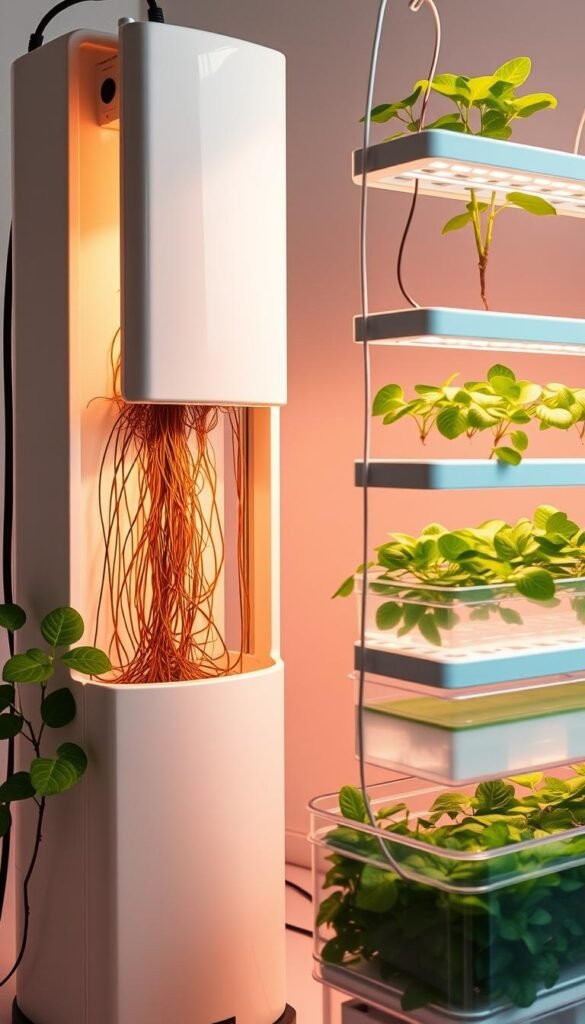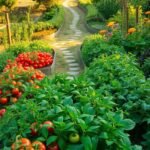Gardening has evolved far beyond traditional soil beds. Today, innovative methods let you grow lush, healthy plants without dirt. Two popular options—hydroponics and aeroponics—use water-based solutions to deliver nutrients directly to roots. But how do you choose between them?
Both systems maximize space and resources. Hydroponics suspends plant roots in nutrient-rich water, while aeroponics mists them with a fine spray. This soil-free approach speeds up growth and reduces pests. Whether you’re growing herbs indoors or veggies on a balcony, these methods adapt to modern lifestyles.
This guide breaks down how each technique works. You’ll learn about setup costs, maintenance needs, and ideal crops. We’ll also explore which system suits small spaces, tight budgets, or specific plant types. By the end, you’ll feel confident picking the right option for your goals.
Key Takeaways
- Both methods eliminate soil, using water and nutrients to feed plants
- Hydroponics relies on submerged roots, while aeroponics uses misting
- Space efficiency makes these systems ideal for urban settings
- Growth rates often outperform traditional gardening
- Initial costs and maintenance vary between the two approaches
Introduction to Innovative Soil-less Growing Methods
Imagine harvesting fresh greens year-round without a single speck of soil – that’s today’s gardening reality. Traditional plots are making way for systems that deliver nutrients directly to roots through water or mist. This shift lets you grow more in less space while cutting down on common gardening headaches.
Overview of Modern Gardening Techniques
Today’s growers use methods tailored for urban spaces and climate challenges. Instead of relying on soil, these approaches optimize air exposure and nutrient absorption. Vertical setups and compact designs let you turn balconies or spare rooms into productive green zones.
Why Choose Soil-less Systems?
You’ll see plant growth accelerate by up to 50% compared to dirt gardening. These methods use 90% less water by recycling solutions in closed-loop systems. They also eliminate soil-borne pests, reducing the need for chemical treatments.
Key benefits driving adoption:
- Year-round growing cycles unaffected by outdoor weather
- Precise control over nutrient mixes for healthier plants
- Smaller environmental footprint through resource efficiency
Understanding the Fundamentals of Aeroponics and Hydroponics
Roots thrive in new ways through innovative nutrient delivery systems. Both methods bypass soil entirely, letting plants access food more efficiently. You’ll discover how each technique creates unique growing conditions below.
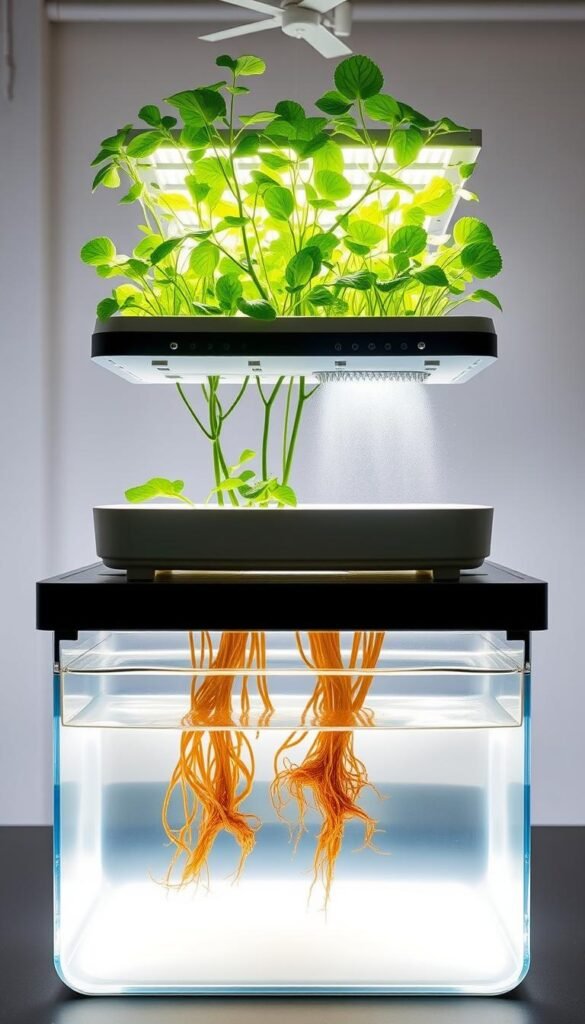
Core Concepts Explained
Hydroponic systems grow plants with roots submerged in water enriched with minerals. This approach keeps roots constantly fed but requires careful monitoring of pH levels. In contrast, aeroponics suspends roots in air and mists them with a nutrient-rich spray every few minutes.
Key differences emerge in root exposure:
- Hydroponics uses reservoirs or flowing channels to bathe roots
- Aeroponics leaves roots mostly dry between mist cycles
- Both methods deliver precise nutrient solutions for faster growth
How Plants Get Their Food
Your greens absorb nutrients differently in each setup. Hydroponic systems flood roots with liquid, allowing direct uptake through constant contact. Aeroponic mist provides oxygen-rich environments that boost absorption rates by up to 40%.
| Method | Root Environment | Feeding Frequency | Water Use |
|---|---|---|---|
| Hydroponics | Submerged in solution | Continuous | Moderate |
| Aeroponics | Air with periodic mist | Every 2-5 minutes | Low |
This table shows why aeroponics uses less water while achieving similar growth speeds. Both systems outperform soil gardening, but your choice depends on space, budget, and desired involvement.
Hydroponic System Varieties and Techniques
Modern growers have multiple hydroponic options to explore. Each method tailors nutrient delivery to suit different spaces, budgets, and plant types. Let’s unpack the most effective setups for maximizing growth and resource efficiency.
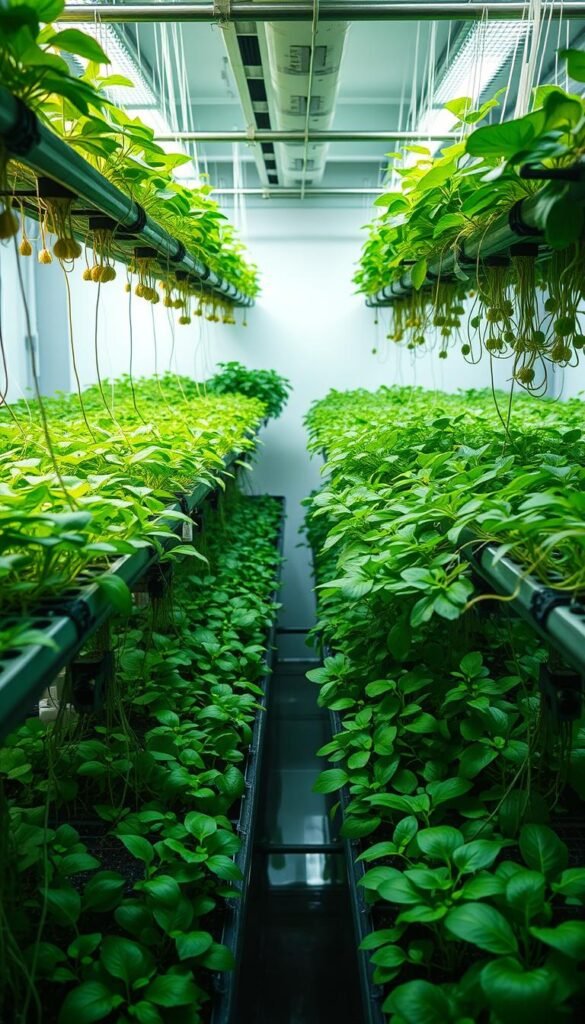
Deep Water Culture and Nutrient Film Technique
Deep Water Culture (DWC) keeps roots fully submerged in oxygen-rich water. Air stones bubble through the reservoir, preventing rot while delivering nutrients. This low-maintenance approach works well for fast-growing greens like lettuce.
Nutrient Film Technique (NFT) uses shallow channels to circulate a thin stream of water. Roots absorb what they need as the solution flows past them. This method shines with compact herbs and strawberries, using 70% less water than traditional gardening.
Other Hydroponic Setups and Their Applications
Drip systems feed plants through timed tubing, ideal for tomatoes or peppers. Ebb-and-flow setups periodically flood grow trays, offering versatility for mixed crops. Wick systems use passive absorption—perfect for small-space herbs.
| System | Setup Complexity | Water Use | Best For |
|---|---|---|---|
| DWC | Low | Moderate | Leafy greens |
| NFT | Medium | Low | Herbs, strawberries |
| Drip | High | Moderate | Fruiting plants |
Urban gardeners often combine these systems with vertical stacking. Rooftop farms might use NFT channels, while apartment growers favor compact DWC buckets. Your choice depends on available space and desired crops.
Aeroponic Gardening Explained
Picture roots dangling freely in a humid chamber, absorbing food through microscopic droplets. This cutting-edge approach skips water baths entirely, using precise misting cycles to feed plants. Unlike hydroponic setups, roots here never sit in liquid—they thrive in suspended air packed with oxygen.
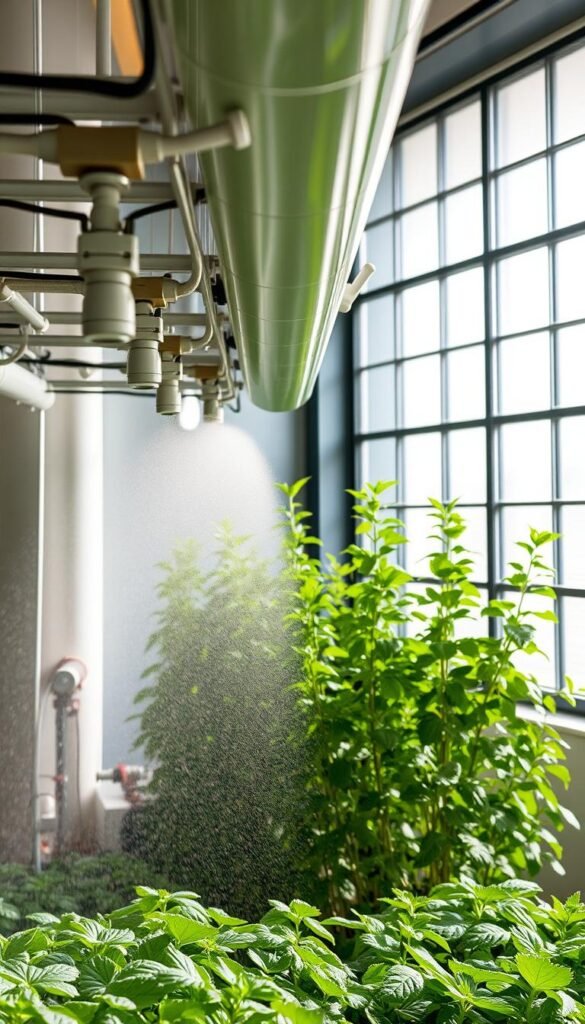
Principles Behind Aeroponic Systems
The magic happens when roots hang in darkness, exposed to high humidity. A pump sprays nutrient solution directly onto them every few minutes. This timed misting prevents waterlogging while maximizing oxygen absorption—a key factor for rapid development.
You’ll notice two main system types. Low-pressure setups use simple spray nozzles, ideal for home growers. High-pressure systems create ultra-fine mist particles, preferred by commercial farms. Both keep roots 70% drier than hydroponic methods, reducing rot risks.
Types of Aeroponic Implementations
Compact tower gardens suit urban spaces, stacking plants vertically. Larger operations might use horizontal rails with automated misters. Some advanced models even adjust spray intervals based on plant growth stages.
Key advantages make aeroponics stand out:
- 30% faster maturation compared to soil gardening
- 90% less water usage than traditional methods
- Reduced pesticide needs due to sterile environments
However, these systems demand reliable power for constant misting. Clogged nozzles can disrupt growth if not monitored. Many growers pair backup batteries with pH sensors to maintain ideal conditions.
Aeroponic vs. Hydroponic Gardening: Which Is Right for You?
Choosing between mist-fed and water-bathed growing setups depends on your priorities. Let’s explore how these systems differ in daily operation and long-term results.
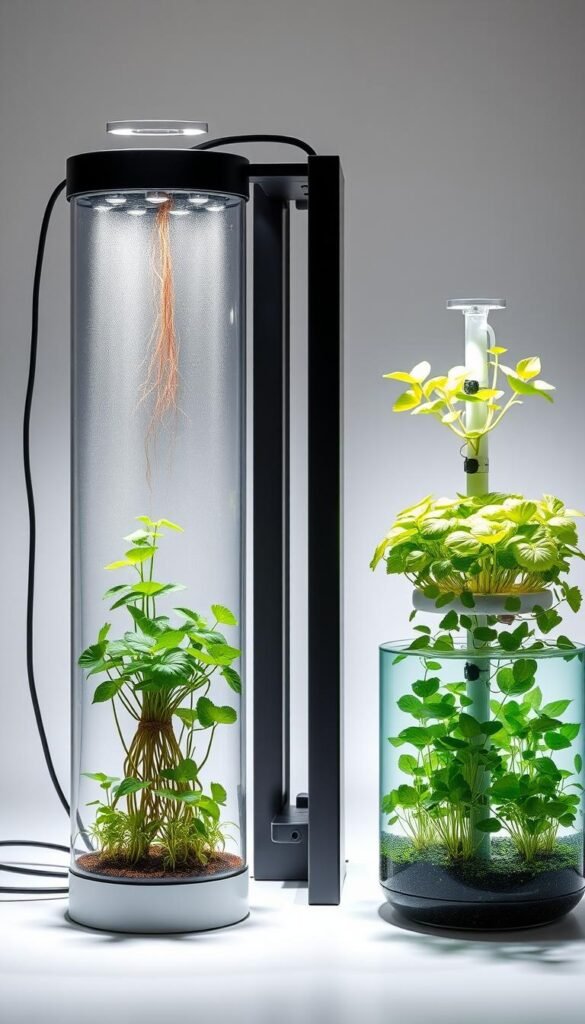
Comparing Key Features Side by Side
Hydroponics keeps roots submerged in nutrient-rich water, requiring constant oxygen flow. Aeroponics suspends roots in air, misting them every few minutes. This fundamental difference impacts everything from energy use to crop selection.
| Feature | Hydroponic Systems | Aeroponic Systems |
|---|---|---|
| Root Environment | Water-based solution | Air with nutrient mist |
| Water Use | Moderate (circulated) | Low (recycled spray) |
| Energy Needs | Pump & air stone | High-pressure misters |
Hydroponic setups generally cost less upfront but use more water. Aeroponic models demand precise timers and frequent nozzle checks. Your space matters too—vertical towers work well for mist-based growth, while horizontal channels suit water-based methods.
Consider these factors when deciding:
- Budget for equipment and electricity
- Time available for system monitoring
- Types of plants you want to grow
Leafy greens thrive in both systems, but delicate plant roots often prefer misting. If power outages are common, hydroponics offers more forgiveness. Urban gardeners with tight spaces might lean toward aeroponics’ compact design.
Exploring the Pros and Cons of Each Method
Modern growers face exciting choices when selecting soil-free setups. Both methods deliver impressive results but come with distinct trade-offs. Let’s break down what works best for different scenarios.
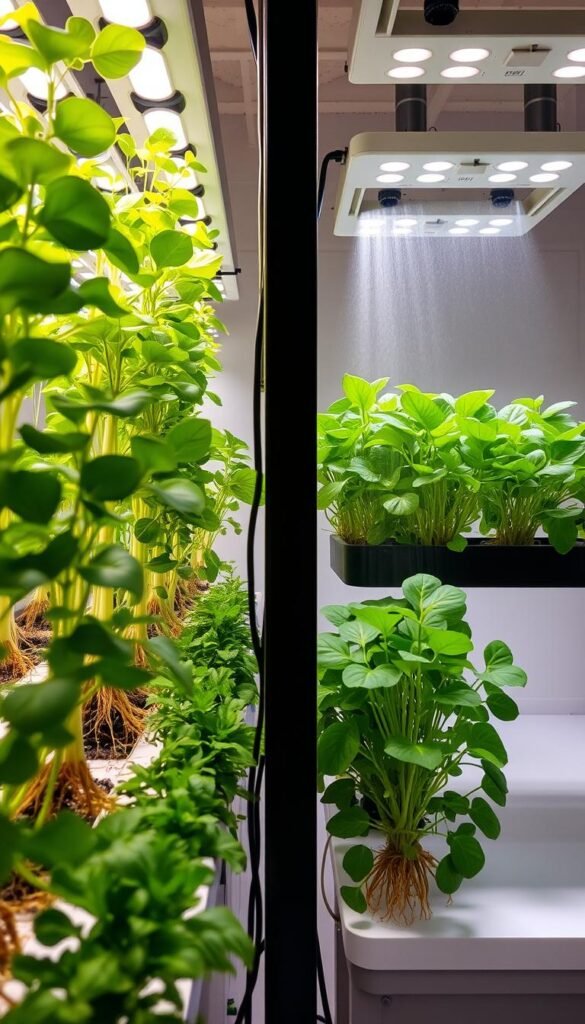
Advantages: Faster Growth, Lower Water Usage
Aeroponics shines with rapid development—plants grow 30-50% faster than in soil. Roots bathed in suspended air absorb nutrients 40% more efficiently. You’ll use 95% less water compared to traditional methods, ideal for drought-prone areas.
Hydroponic systems offer simpler entry points. DIY setups using PVC pipes or buckets let beginners start small. The nutrient film technique circulates solutions efficiently, supporting leafy greens and herbs with minimal effort.
- Higher yields per square foot in aeroponic towers
- Lower upfront costs for basic hydroponic kits
- Reduced pest issues in both systems
Disadvantages: Technical Complexity and Power Dependence
Mist-based systems demand precision. Clogged nozzles can starve plant roots within hours. You’ll need backup power sources to maintain spray cycles during outages—a critical factor for commercial growers.
Hydroponics requires frequent pH checks. Stagnant water risks root rot if oxygen levels drop. While easier to maintain, recirculating nutrient solutions demands weekly monitoring.
| Factor | Aeroponics | Hydroponics |
|---|---|---|
| Growth Speed | 30-50% faster | 20-30% faster |
| Water Efficiency | 95% less usage | 70-80% less usage |
| System Failures | Immediate plant stress | Slower deterioration |
Urban gardeners often mix methods—using hydroponics for herbs and aeroponics for high-value crops. Your choice ultimately depends on reliability needs and willingness to troubleshoot tech.
Cost Implications, Setup, and DIY Considerations
Your gardening budget determines which soil-free method fits your wallet and workflow. Aeroponic setups typically cost 30-50% more upfront than hydroponic systems due to specialized misters and timers. However, they use less water and nutrients over time, balancing initial investments with long-term savings.
Basic hydroponic kits start around $100 using deep water culture or drip irrigation. You can build DIY versions with buckets and air pumps for under $50. Aeroponic systems often require $300+ for commercial-grade components but offer 40% faster growth rates to offset costs.
Compare ongoing expenses:
| Expense | Hydroponics | Aeroponics |
|---|---|---|
| Water | 5-10 gallons weekly | 2-4 gallons weekly |
| Electricity | $8-12/month | $15-20/month |
| Nutrients | High consumption | Precise dosing |
Three cost-saving strategies for DIY enthusiasts:
- Repurpose plastic containers for water culture reservoirs
- Use aquarium pumps in hydroponic setups
- Install timers from old electronics for mist cycles
Home growers often mix methods—combining aeroponic efficiency for herbs with hydroponic simplicity for leafy greens. Commercial farms prioritize aeroponics’ space-saving design despite higher startup costs. Your choice hinges on balancing technical skills with budget flexibility.
Water Efficiency and Environmental Impact
Growing plants without soil slashes water use dramatically—up to 95% in advanced setups. Traditional farming guzzles resources, but these systems recycle every drop. You’ll save 80-90% with hydroponics and even more with mist-based methods.
Here’s why it matters. Closed-loop designs prevent runoff, keeping fertilizers out of waterways. Roots absorb nearly all nutrients, unlike soil where excess drains away. This precision cuts waste and protects ecosystems.
| Aspect | Hydroponics | Aeroponics |
|---|---|---|
| Water Saved vs. Soil | 80-90% | 95% |
| Land Needed | 1/5th space | 1/10th space |
| Energy Use | Moderate pumps | High-pressure misters |
Smaller footprints mean you can grow more in urban areas. Vertical towers use 90% less land than fields. Less water pumping also trims energy bills—ideal for eco-conscious growers.
Enclosed setups shield crops from weather extremes. No pesticides leak into groundwater, and grow lights optimize photosynthesis year-round. Your herbs thrive while leaving a lighter planetary footprint.
Enhancing Plant Growth, Yields, and Overall Health
Your plants reach maturity faster when roots access nutrients and oxygen optimally. Studies show crops in aeroponic setups grow 35% quicker than hydroponic ones by week six. This speed comes from mist-fed roots absorbing minerals more efficiently.
Precision matters. Aeroponics delivers nutrient solution in ultra-fine droplets, coating every root hair. Hydroponic systems bathe roots continuously, which works well but limits oxygen exposure. Both methods outperform soil, but misting creates ideal air-to-water ratios for rapid cell development.
| Growth Factor | Aeroponics | Hydroponics |
|---|---|---|
| Days to Harvest | 24-28 | 32-38 |
| Leaf Size Increase | 40% | 25% |
| Fruit Yield | 20% Higher | Baseline |
Tech upgrades boost results. Smart sensors now adjust mist cycles based on plant growth stages. Some systems pair LED lights with custom nutrient mixes for specific crops. These tools help you hit harvest targets consistently.
Try these tips to maximize output:
- Check pH daily—5.8-6.3 works best for most greens
- Use air stones in hydroponic reservoirs for better root oxygenation
- Clean mist nozzles weekly to prevent clogs in aeroponic units
Roots in mist environments develop thicker secondary networks, absorbing 50% more minerals. Hydroponic roots grow longer but may struggle with water saturation. Both methods deliver healthier plants—your choice depends on desired speed versus maintenance ease.
Conclusion
Transforming how we cultivate greens starts with understanding modern growing techniques. Hydroponic systems nourish roots through water-based solutions, while their mist-driven counterparts optimize oxygen exposure. Both methods slash water use by 80-95% compared to soil gardening, making them eco-friendly choices for urban spaces.
Consider your priorities. Hydroponics offers simpler setups with lower upfront costs—ideal for beginners. Aeroponics demands precise timers but rewards you with faster growth and minimal water waste. Maintenance differs too: one requires pH monitoring, the other nozzle checks.
Key factors to weigh:
- Budget for equipment and monthly energy costs
- Time available for system upkeep
- Space constraints and crop types
Urban growers often favor vertical aeroponic towers for herbs, while hydroponic channels suit leafy greens. Both approaches eliminate soil-borne pests and deliver nutrient-rich harvests year-round. Your decision hinges on balancing efficiency with hands-on involvement.
Ready to start? Match your goals to these innovative systems. Whether you prioritize speed, savings, or sustainability, you’re growing smarter—one thriving plant at a time.
